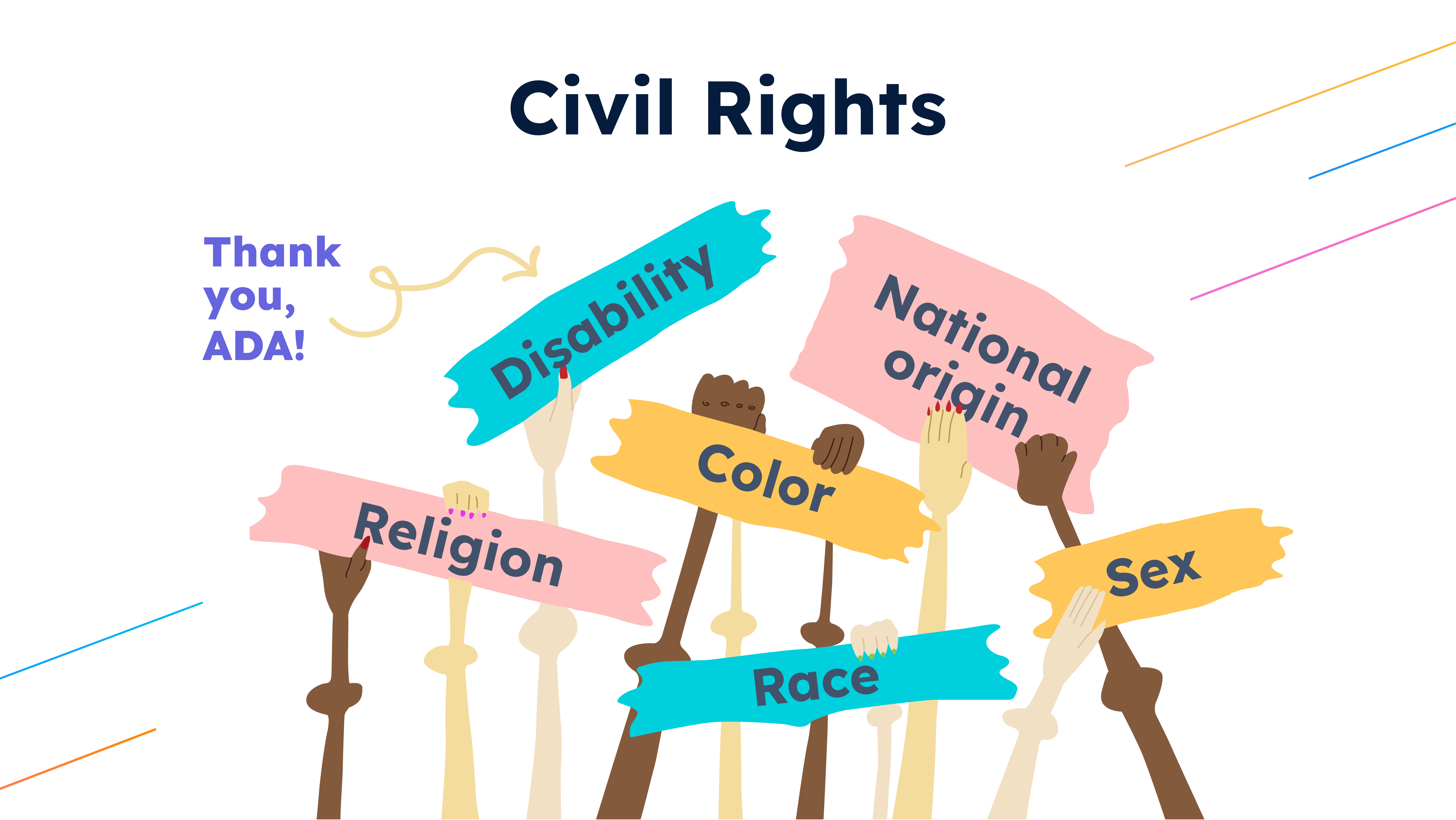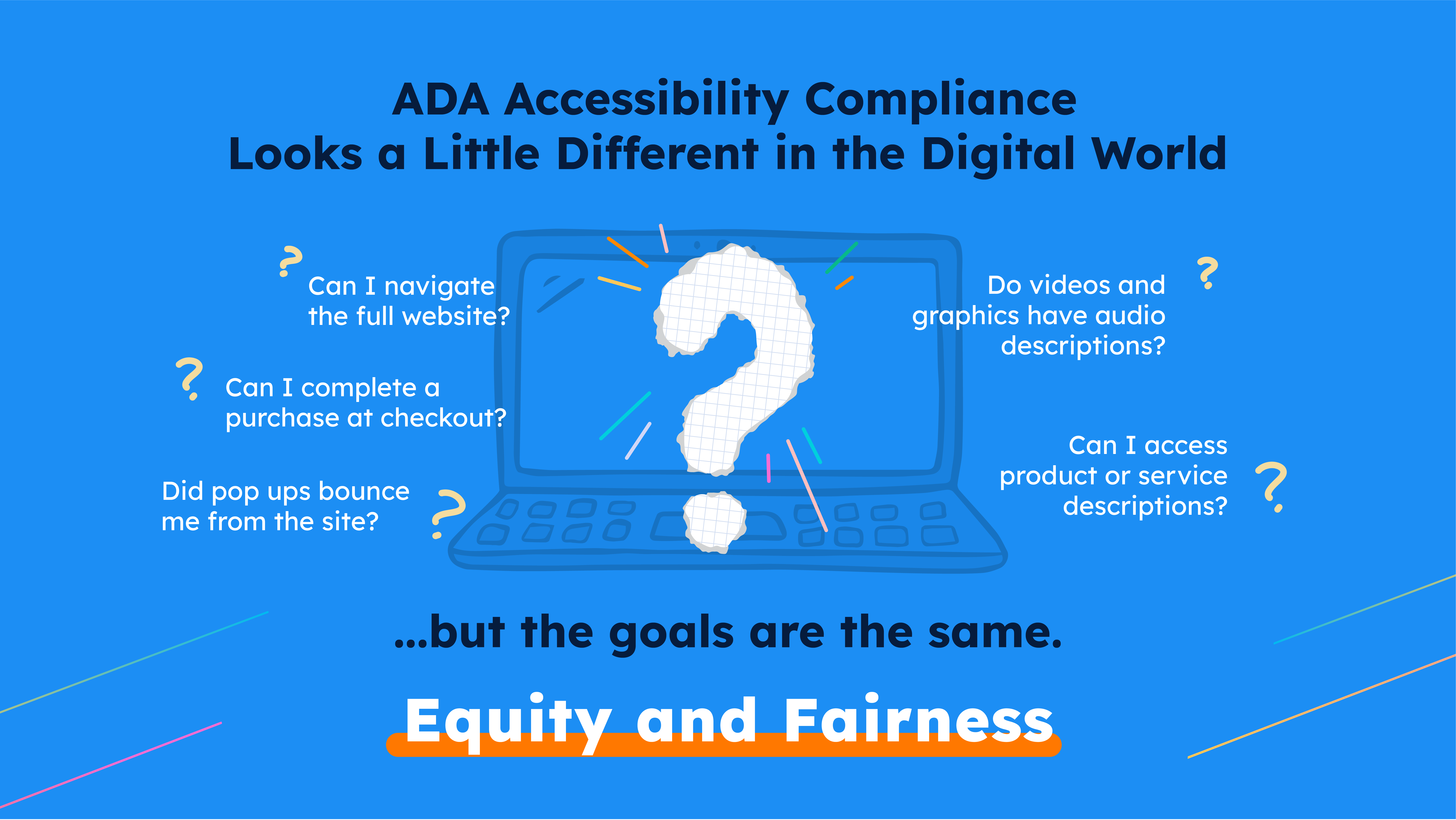
A Brief History of Accessibility: From Storefronts to Homepages
It has often been said that the very definition of privilege is not having your rights, access, or quality of life hinge on the passing of a law. Perhaps the most tangible example of this concept is seen through the evolution of the American civil rights movement, which ultimately codified equality of access to life in the public sphere for Black Americans and others. Privilege in this context, of course, describes the experience of all those for whom nothing changed as far as their rights, access, or quality of life from one day to the next based on the passage of the Civil Rights Act of 1964. But for anyone who had been experiencing life through the lens of discrimination, denial of access, or blatant disparagement based on race, color, religion, sex, or national origin, the passage of this law meant everything.
The passage of the Americans with Disabilities Act (ADA) recognized, valued, and legally enforced the civil rights of people with disabilities in similar and important ways. We’ll take a look at life before the ADA, the highlights of how its passage changed the retail commerce experience for people with disabilities, and its evolution into the world of online commerce.
Life Before the ADA
For people living with disabilities, the passage of the Americans with Disabilities Act (ADA) in July of 1990 was a life-altering game-changer that brought the rights of people with disabilities into the civil rights fold. Prior to this time, people with disabilities were openly discriminated against in public transportation, public and private employment, housing, retail shopping, and public spaces. To highlight the impact of this pivotal legislation, the National Museum of American History identified shocking ways that people with disabilities were treated prior to the ADA affording them explicit rights.
The traumas legally permitted against people with disabilities prior to this law included:
• being rejected for jobs based solely on their having a disability rather than on their ability to perform the essential functions of the job
• being paid less because they had a disability, even though they were performing the same functions and had the same talents or experience as people without disabilities
• being denied access to public transportation, such as taxis, trains, buses, etc., in a way that enabled them to remain in their wheelchairs and use other assistive accessibility aids
• being denied access to businesses or services open to the public, such as restaurants, grocery stores, libraries, etc., because the entry, building, bathrooms, hallways, aisles, etc., were not accessible or designed for use by people with disabilities
• being denied access to useable public or private restrooms while out in the public space
• being unable to navigate public sidewalks and streets with ease because curb cuts in sidewalks were not required
A Game-Changer!
When then-President George H.W. Bush signed the ADA into law, it meant that public and private entities had to account for people with disabilities in the design and implementation of urban and retail spaces, transportation, restrooms, and more. People could no longer be fired, paid less, or rejected from jobs and opportunities simply because they had a disability. For people with disabilities, the ADA gave them the right to some of the most seemingly basic necessities of life in a concrete way for the very first time.

Does this mean that life changed overnight? Of course not! Initially, while advocates celebrated, businesses resisted, organizations pushed back, and taxpayers balked. Why? Implementing improvements within an outdated system requires time, planning, and investment. People didn’t want to invest in infrastructure, make a commitment to centering accessibility, or change the ways they had been doing things…or thinking about things. It took time to open minds to the understanding that for people with disabilities, the only obstacles to success and equity were the obstacles put in their way by other people.
How Lawsuits Played a Role
Government regulation of civil rights for disabled people was the first step in a longer process that rolled out over time. One of the early drivers of change was the ability of people, organizations, and advocates to bring lawsuits demanding accessibility improvements and enforcing their rights under the ADA. This meant, for instance, filing lawsuits against businesses that refused to make reasonable accommodations to allow access to people who use wheelchairs and other similar scenarios.
Eventually, the threat of lawsuits and regulatory fines, along with the gradual shifting of deep-rooted perspectives on the diversity and wonder of human potential in all its forms, led to the implementation of change from the outset. So, new construction, additions, and updates all included modifications and original designs aimed at meeting ADA standards and ensuring accessibility to everyone.
Today, though people with disabilities still face profound accessibility challenges and still have to shoulder the burden of advocating for change, the brick-and-mortar world has come a long way toward more adequately making space for diverse physical needs and embracing inclusivity, equity, and accessibility for everyone.
When Storefronts Became Homepages
Just about everyone who has access to technology these days recognizes the massive cultural shift that has taken place. While brick-and-mortar buildings still house a range of professional, commercial, and retail spaces, there is no question that eCommerce has shifted our consumer habits and become a massive driver of economic growth and engagement. When someone needs to find a lawyer, buy a watch, apply for a job, enroll in a program, order gifts, etc., many people begin and end that process online.
This shift is spurred in large part by a desire for ease of access and process. Sitting at home at your desk, on your sofa, or even in your bed means that you can accomplish almost any task with the convenience of not having to leave the house, look presentable, find a sitter, have transportation, etc. Online consumerism has also allowed for a greater range of geographical spending, more pricing options, consideration of consumer reviews, and other factors. In other words, it emphasizes and enables ultimate convenience. In fact, even with those stores that will likely retain physical locations, such as grocery stores and restaurants, we see that online ordering and delivery form an ever-increasing percentage of sales.
Online Accessibility and the ADA
When storefronts got replaced by homepages, this modern convenience proved to be rich ground for a new breed of accessibility hurdles- ones largely impacting individuals who are blind or low-vision. And just like that….the convenience of online consumerism became a privilege that can’t be shared or experienced equitably.
With this new accessibility terrain came a need for regulatory expansion and intervention. Enter the ADA, Section 508, and the WCAG global standards. As accessibility awareness grows across the webscape, these laws serve as both an aspirational guidepost for business compliance and a legal framework for the enforcement of basic rights. We see this in the online mirroring of early ADA growth across physical accessibility barriers, such as lawsuits and regulatory fines, which have played a similar and equally integral role in propelling change across the eCommerce industry.
Online accessibility, also commonly referred to as digital accessibility, is primarily distinguished by the ability of people with sensory disabilities to have full navigational and functional use of a website. So, from the moment someone with low or no vision or hearing lands on a website until the moment they complete a purchase through the checkout, they should have equal access to the full experience of the website.
The Digital Accessibility Landscape
There are numerous ways that digital accessibility is assessed and evaluated, including taking into account factors such as whether pop-ups interfere with navigational abilities, whether product or service descriptions are accessible, and whether videos and graphics have audio descriptions available.
An interesting aspect of ADA compliance in the digital world is that compliance failings can impact greater numbers of people on a regular basis and can be monitored and assessed more broadly. Where a brick-and-mortar storefront may encounter a more limited number of people in a given time period, online stores and organizations can potentially receive exponentially more traffic from a broader geographical scope, making it harder for businesses to shirk compliance and risk taking a roll of the dice that they won’t get hit with fines or lawsuits.

ADA Expansion is Welcomed
By recognizing the importance of embracing an expansive view of the ADA and welcoming the emergence of complementary legislation aimed at protecting people with disabilities in this new and ever-evolving sphere of human existence, we are collectively acknowledging the importance of valuing and centering inclusivity and equity across all aspects of modern life.
At AllyADA, we applaud the movement to bring conformity and accessibility to the world of eCommerce and embrace continued advancements toward a fully inclusive online marketplace.
Call or reach out today to learn how we can help bring your website into compliance and keep it there. The advanced manual reviews conducted by our CPACC-certified accessibility professionals, in conjunction with state-of-the-art technological assessments, put our services at the forefront of next-generation compliance. We help your business bask in the benefits of ADA compliance while changing the world for the better, one website at a time!
